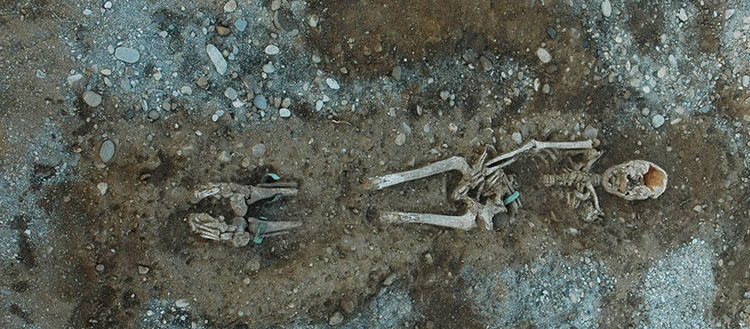
Today, archaeological resources for studying the Bronze Age are limited. "This is partly down to changes in funeral rituals," begins Mireille David-Elbiali, an archaeologist in the Laboratory of Prehistoric Archaeology and Anthropology in the F.-A. Forel Department in UNIGE's Faculty of Sciences. "People gradually abandoned the inhumation practice in favour of cremation, thereby drastically reducing the bone material needed for research. And yet the Bronze Age signals the beginning of today's societies with the emergence of metallurgy." As the name suggests, societies began working with bronze, an alloy consisting of copper and tin. "And this development in metallurgy called for more intensive trade so they could obtain the essential raw materials. This increased the circulation of traditional crafts, prestigious goods, religious concepts and, of course, people between Europe and China," continues the archaeologist.
Diet imprinted in bones
The Neolithic Age marked the inception of animal husbandry and the cultivation of wheat and barley. But what about the diet in the next Bronze Age? Archaeobotany and archaeozoology have been routinely used to reconstruct the diet, environment, agricultural practices and animal husbandry in the Bronze Age, but these methods only provide general information. "For the first time, we decided to answer this question precisely by analysing human and animal skeletons directly. This meant we could study the stable isotopes from the collagen of the bones and teeth that constitute them and define their living conditions," continues Alessandra Varalli, a researcher in the Laboratory of Prehistoric Archaeology and Anthropology in the F.-A. Forel Department at UNIGE and the study's first author. "In fact, we are what we eat," points out Marie Besse, a professor in the Laboratory of Prehistoric Archaeology and Anthropology in the F.-A. Forel Department at UNIGE. Biochemical analyses of bones and teeth will tell us what types of resources have been consumed." Forty-one human skeletons, 22 animal skeletons and 30 plant samples from sites in Western Switzerland and Haute-Savoie (France) were studied, ranging from the beginning to the end of the Bronze Age.
No differences between men, women and children
The study's first outcome showed that there was no difference between the diets of men and women, and that there were no drastic changes in diet between childhood and the adult phase of these individuals. "So, there was no specific strategy for feeding children, just as men didn't eat more meat or dairy product than women. What's more, when it comes to the origin of the proteins consumed, it was found that although Western Switzerland is home to a lake and rivers, the diet was mainly based on terrestrial animals and plants to the exclusion of fish or other freshwater resources," adds Dr Varalli. But the main interest of the study lies in plants, which reveal societal upheavals.
Agriculture adapted to climate change
"During the early Bronze Age (2200 to 1500 BC), agriculture was mainly based on barley and wheat, two cereals of Near Eastern origin that were grown from the Neolithic Age in Europe», explains Dr Varalli. "But from the late Late Bronze Age (1300 to 800 BC), we note that millet was introduced, a plant from Asia that grows in a more arid environment." In addition, nitrogen isotopes revealed that manuring was used more intensively. "The analysis of several plant species from different phases of the Bronze Age suggests that there was an increase in soil fertilisation over time. This was most likely to boost the production of agricultural crops."
These two discoveries combined seem to confirm the general aridity that prevailed in Europe during this period, which meant agriculture had to be adapted; and that there was heightened trade between different cultures, such as Northern Italy or the Danube region, leading to the introduction of millet into Western Switzerland. These new cereals might have played an important role in the security of supply, and perhaps contributed to the population increase observed in the Late Bronze Age. In fact, these cereals grow more quickly and are more resistant to drought, at a time when the climate was relatively warm and dry. Finally, the use of fertiliser went hand-in-hand with a general improvement in techniques, both agricultural and artisanal. "This first study on changes in diet in Western Switzerland during the Bronze Age corroborates what we know about the period. But it also demonstrates the richness of the widespread intercultural exchanges," states Professor Besse with enthusiasm. We still have much to learn about this millennium, in spite of the scientific problems related to the paucity of available material. "This is one of the reasons that led me to excavate the Eremita cave with UNIGE students. Located in the Piedmont region of Italy, it is dated to the Middle Bronze Age around 1600 BC," concludes Professor Besse.



Comment: As other studies have revealed, it would be interesting to know just exactly what their diet was made up of, in what quantities, as well as the overall health of the people studied: